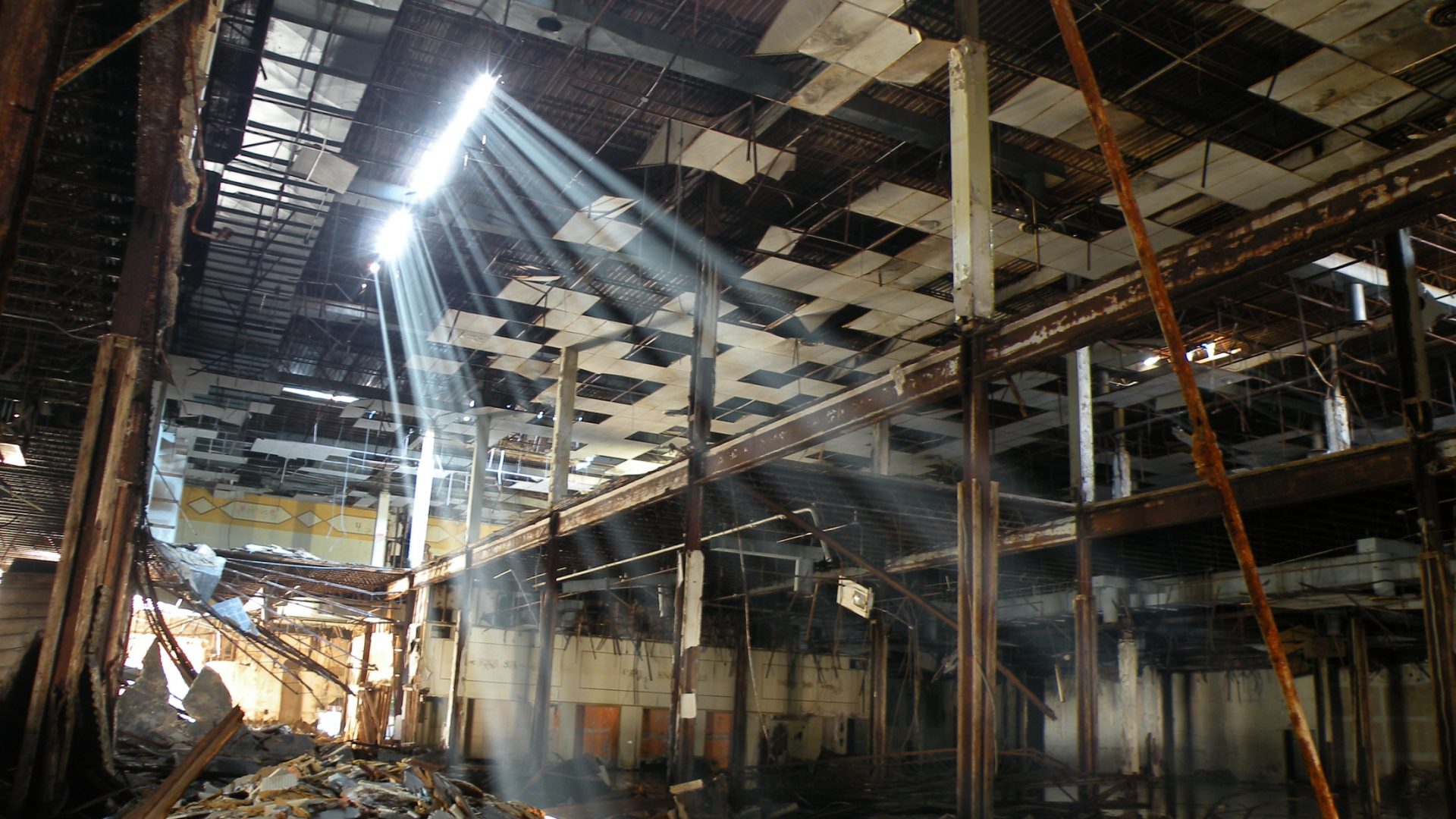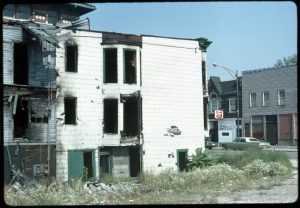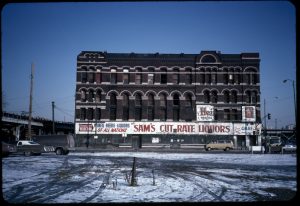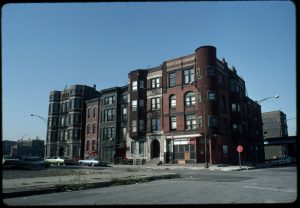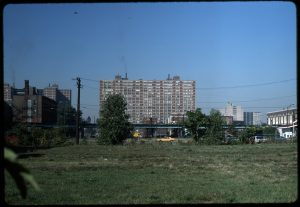| Origins | Settled by Jean Baptiste Point Du Sable in 1788 and annexed c. 1837 |
|---|---|
| Area | Central Chicago |
| Boundaries | Evergreen Avenue on the north, Chicago River on the south, Lake Michigan on the east, North Branch Chicago River on the west; Cabrini Green neighborhood: Division Street on the north, Chicago Avenue on the south, Lasalle on the east, Larabee on the west; Goose Island neighborhood: North Avenue on the north, Chicago Avenue on the south, Larabee Street on the east, Chicago River on the west. Little Hell was all of Cabrini Green area and Goose Island |
| Gangs headquartered | Mickey Cobras, Vice Lords, |
The Goose Island and Cabrini areas in the southwest quadrant of the Near North Side neighborhood would become the home some of the first gang banging and organized crime elements in Chicago history. Most of it was going on in the Cabrini Green area that was nicknamed “Little Hell” as early as the late 1850s.
In the year 1853 manufacturing industries were built on Goose Island that offered employment to the many impoverished Irish immigrants that lived in shabby dwellings in and near the island. The neighborhood got the nickname “Little Hell” from the gas flames that lit up the night sky from the Peoples Gas, Light & Coke Co at the corner of Hobbie Street and Cleveland Street. In the late 1850s underground gambling dens and brothels were literally operating underneath the ground and brought about shady criminal groups in the downtown area.
Many early immigrants built their own homes. The homes were built poorly, and many were just shacks and small cottages. Many of these families could not afford proper material to build their own homes and some families lacked skill at building homes, this made for an instantly blighted and ran down neighborhood. The factory work nearby was low pay and unhealthy dirty conditions that polluted the Goose Island and Little Hell areas with soot.
A strip of land located in the present day Streeterville area in the Near North Side neighborhood was always home to several saloons and cheap motels for dock workers and travelers along the Chicago River banks (Fact source: Digital Research Library of Illinois History Journal, Neil Gale PH. D). To give you an idea of where this area was located, it was right where Rush Street meets the river on the north side of the river. The Wrigley Building and Chicago Tribune building currently sit in this area. As this area aged it became a haven of impoverished and for the gambling and vice rackets of the city. Soon much of the worst criminal element moved to this part of the city famously known as “The Sands,” named after the white sands along this river front. Many of the residents here built poorly constructed shacks that often caught fire or just collapsed. Some lived in the old buildings that were decaying. Almost all these thirty some odd structures were gambling dens and brothels. Crime was rampant after this area took shape in the early 1850s. Very dark crimes were committed here, and murders were a normal occurrence.
In the year 1855 the city at last organized a adequate police force but it was far too late as the underworld in Chicago had already grasped organized crime, although absent of an organized crime group, the underworld was learning scattered organized crime type practices as they were taught by gamblers, pimps and wild packs of criminals imported from other states an other countries. This was foundation and the backbone for the beginning of organized crime that would lead to our first gang elements in this city. Chicago was already becoming well advanced in the business of crime before this city had more than three police officers and the money potential was exponential, all that was needed was for someone or some group of people to take control of it.
In the year 1857 Mayor John Wentworth had enough of the Sands and now wanted to see it eradicated from this earth. The Sands became the hub of pimps, prostitutes, gamblers, and many wanted and dangerous criminals. Many of the criminals hiding out in the Sands were stone cold killers and very dangerous. Some of these criminals attacked citizens at will and were known for being quick with the trigger. This became a serious criminal and sociological problem in early Chicago society and the only way to get rid of this element was to do something extreme because even the new police force was too scared to go in and enforce laws. approximately thirty ran down shacks were in the sands full of brothels and gambling dens as fights, extreme intoxication and filth plagued this neighborhood. Plenty of murders happened almost daily here and violence was very common (Fact source: Digital Research Library of Illinois History Journal, Neil Gale PH. D). This was the first dangerous area of the city and the first area of the city where criminals gathered which laid foundation for this city’s future of organized crime and gangs. When several criminals operate in an area alongside each other organizations eventually develop.
In April of 1857 William Ogden now legally purchased all the land that comprised of the Sands. He was able to do this because the criminal element living there were just squatters, no one on the Sands had legal right to this land and were only entitled to squatter’s rights. William Ogden had big plans to be the landlord to several big businesses and to have a big part in the construction of the new Randolph Street bridge. Ogden was in the process of doing business with lumber yards, The Great Sugar Refinery, the ice houses of Messrs, Joy and Frisbie and a J.H. Reed warehouse (fact source Chicago Tribune August 13, 1859). Ogden ordered the squatters to leave the land he just purchased but of course they refused to leave. Ogden then complained the Wentworth and Wentworth was all too happy to help. On the day of April 20, 1857, Wentworth arranged for a dog fight between Sands brothel owner Dutch Frank and the Market Street butcher William Gallager’s dog at the Brighton Racetrack located at Archer Avenue and Western Avenue in the McKinley Park neighborhood on the south side of the city. The advertisements were posted all over the Sands and boasted of a $500 cash prize. As the men of the Sands flocked to this event leaving most of the Sands vacant, Wentworth and Ogden came to the Sands with a team of thirty police officers and firemen. They had large iron hooks attached to the end of tackles on horse drawn carriages. They placed the hooks at the base of the foundations and tore the shacks to the ground. The ones that were sturdier were set on fire and burned to ash (Fact source: Gleanings of Archer Road by Joseph Hamzik). When the inhabitants returned, they started a violent riot looting their neighbors and setting fires causing destruction and mayhem through the rest of the district but in the end Wentworth and Ogden won successfully wiping out the first criminal neighborhood in Chicago history (Fact source: Digital Research Library of Illinois History Journal, Neil Gale PH. D).
After the Sands was removed in 1857 much of the criminal element shifted to the Loop neighborhood but much of it also landed on the streets of Little Hell as this neighborhood become the most violent dangerous places in the entire city that police dreaded patrolling and seldom did at night.
The area known as Little Hell was so deteriorated and dilapidated that many families slept on soil that was covered only by cardboard in their apartment dwellings or shantytowns. The area severely lacked running water which caused more unsanitary conditions and living a life of filth. These streets were mean and dirty which created the first violent criminal elements the city had ever seen. Scores of Irish street gangs popped up in this section of the neighborhood and many were hired by crooked politicians and Irish organized crime to do dirty work for mere pennies.
In the 1880s the area was settled by Sicilian immigrants, and by the 1890s the Sicilians were fully partaking in gang activity. The area was so bad that Chicago police did not want to enter this area especially the intersection of Milton and Oak Street (today known as Cleveland and Oak Streets) that was nicknamed “Death Corner” due to the fact that many people were killed there especially in the early 20th century.
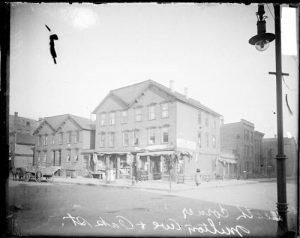

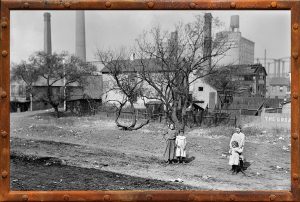
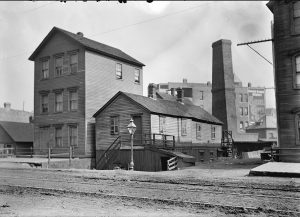

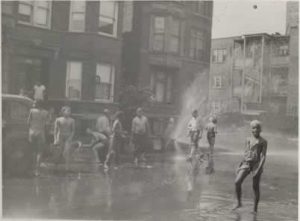
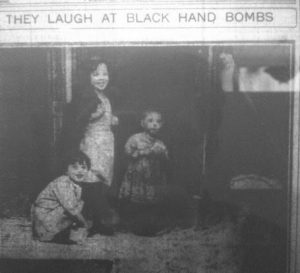




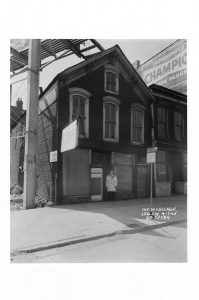

In the 1890s notorious Chicago mob boss Big Jim Colosimo got his start here in Little Hell in the criminal life when he began working for the crooked Irish Chicago politicians the “Grey Wolves.”
By 1902 Big Jim Colosimo had acquired enough money to open his very own brothel and got into the business of kidnapping unsuspecting female immigrant women that came to the U.S. seeking employment from an ad that turned out to be fake, the girls were then forced into a life of prostitution and Colosimo got in on that business.
By 1909-1910 Jim Colosimo began receiving threatening letters from Chicago’s “Black Hand” extortionists that often victimized the wealthy in and near downtown Chicago as this criminal group formed around the turn of the century.
In 1910 Colosimo called upon Johnny “The Fox” Torrio from New York City to help with the problem and from there a war started between Colosimo’s gang and the Black Hand extortionists that resulted in several deaths especially at Death Corner where the “Shotgun Man” took many lives between 1910 and 1911.
By 1912 Colosimo’s gang won the war thanks to the assistance from Torrio and the two men put together the “Chicago Outfit” which was the Italian Mafia here in Chicago that was a part of “La Cosa Nostra” that stemmed from Sicily. Most of Colosimo’s operations were in the Near South Side neighborhood but he controlled much of the Sicilian organized crime in Little Hell too.
During the 1910s, 1920s and 1930s mob wars raged in Little Hell especially when the “North Side Gang,” the new Irish Mafia, tried to run this whole section but they conflicted with rival Sicilian gangs such as the Genna Crime Family for example. The North Side Gang was born on these wicked streets of Little Hell along with their rivals. The gang wars were extremely bloody in the 1910s and 1920s and many youth gangs worked for the older gangs trying to gain notoriety in hopes that one day they would gain passage into these organized gangs.
In the year 1929, the Marshall Fields apartments were built. This large apartment structure became a privately funded housing project that was not connected to the Chicago Housing Authority. This was a philanthropy project to provide housing to lower income Chicagoans.
In the 1930s African Americans began migrating into this neighborhood because this was an affordable neighborhood for the black family that was drowned in extreme poverty. Some black families were able to settle in the Marshall Fields apartments. The mostly Italian community did not appreciate the arrival of African Americans; therefore, gangs of Italian youths roamed the streets at night hunting down blacks and beating them senseless just to show who ran the neighborhood.
In the year 1942 the solution to the poverty of Little Hell or now known more as “Little Sicily” was to tear down most of the shanty towns and dilapidated buildings and houses and replace it all with the Francis Cabrini Green Low Rise project buildings.
Many Italians left the neighborhood and migrated to West Town along “The Patch” while many other families moved into the projects. The low rises were mainly for white Italian families; however, African Americans were allowed to move into these projects. The projects were 75% white and 25% African American upon opening.
During the World War II years, the projects were mostly happy dwellings where people got along and the projects were well maintained by the Chicago Housing Authority. The arrival of African Americans did not start to become an issue for this mostly Italian neighborhood until after World War II. The Projects were mainly built to house World War II workers but when the war ended so did the war industry leaving many workers destitute and unemployed. The African Americans were the first to lose their jobs and would have the hardest time finding new jobs because this was the 1940s when the white man was put first. Some desperate African Americans resorted to crime to get by which threatened to bring the neighborhood back to the state of terror it was for 80-90 years.
By the later 1940s Italian street gangs formed in the Cabrini Green neighborhood that would patrol the streets to protect the neighborhood, on the other side of the coin, they often bullied groups of black youths and beat them up for almost no reason, so there was good and bad with these gangs.
The earliest wave of Puerto Rican people moved into the Cabrini Green projects and into the Old Town section into a settlement called “La Clark” which was an area bounded by: North Avenue on the north, Division Street on the south, Clark Street on the east and Lasalle Drive on the west in the late 1940s. It was in this settlement where the first Chicago Puerto Rican gang “La Hacha Vieja” may have formed. This group was started because Puerto Rican business were attacked, and Puerto Rican men were attacked on their way to and from work. La Hacha Vieja did the same as the Italian gangs they patrolled their neighborhood looking for intruders.
It became clear that a racial battle had started in the late 40s as Italians became very worried their neighborhood would change, coincidentally the crime was becoming worse in this area.
As the 1950s progressed more and more white Italians packed their bags and left the neighborhood as more African Americans moved into the projects. Many white families were experiencing upward mobility and no longer needed to live in public housing, but African Americans were further behind socially and economically in a large part due to inequality in the work force.
In 1955 the city decided the Cabrini Green projects were a success; therefore, several more Italian homes were torn down to make way for high rise extensions of the projects. Between 1955 and 1958 this extension project continued. By the time the second phase was completed the neighborhood had lost most of its Italian charm and the Cabrini Green neighborhood was now majority African American.
The new extensions saw no Italian residents; in fact, about 100% of the new arrivals were African Americans. White Italians were now vacating the original low rises built in the 1940s.
In the year 1958 when most of the high rises opened, various black street gangs migrated or developed in these projects to fight against white gangs and undesirables. Many times, the gangs patrolled these buildings in the 1960s protecting residents from criminal elements. In 1958 the Egyptian Cobras street gang was born on the south side that quickly spread their influence into Cabrini Green’s 1150 and 1152 buildings and in the Marshall Field Apartments. The Egyptian Cobras would eventually become the Mickey Cobras gang we know today. This group was a revolutionary minded group since their arrival in 1958.
The city was also beginning to plan for the construction of the elegant Carl Sandburg condominiums to be built right over the Puerto Rican settlement, this would mean they would start evicting Puerto Rican families. In 1959, the evictions were complete, and the Puerto Rican families were forced out. Some of these families would move into Cabrini Green while others headed out west and moved to Wicker Park, Lincoln Park, Humboldt Park and various other neighborhoods. This was the extinction of the first Puerto Rican settlement in Old Town known as La Clark.
In 1959, the William Green Homes high rises was started that caused more homes out of Little Sicily to be torn down. By 1960 the projects were all for African Americans as all white Italians had moved out of the buildings. The Italians that were left in the houses surrounding the projects even began to pack up and leave because they did not feel at home anymore, those that remained until 1965 battled the African American gangs that migrated into the projects.
In the year 1961, the Devil’s Disciples arrived in Cabrini Green that would later become a major part of this neighborhood. The Devil’s Disciples would rival Egyptian Cobras.
In the year 1962, the Conservative Vice Lords arrived in this neighborhood settling in the Marshall Fields apartments and in Cabrini Green in the 500 and 502 Oak Street buildings.
The rest of the Italian neighborhood left the Cabrini Green neighborhood as of 1965 along with all Italian businesses and churches.
Up until the mid-1960s Cabrini Green was a safe project that was an ideal place to live. The Chicago Housing Authority took great care of these projects and there was careful screening on tenants. That screening process would become laxer in 1965 when no income residents were allowed to move in, then in 1968 CHA began moving in mostly no income residents. Many of these families had no father figure for the children and were too impoverished to pay any rent. This drained the projects financially and the black working class was angered by this and left the complex to get away from the no-income tenants. This began an era of children unsupervised and running with the streets all day and night. Many children needed father figures, so they turned to gangs.
White street gangs reached their peak between the late 1960s and early 1970s. White flight became so severe in the Cabrini Green, Old Town and Ranch Triangle areas. Many homes could not be purchased as they were left to deteriorate as vacant buildings. Many larger houses were converted into slum lord ran apartments that brought more urban blight to this community. The site of North Ave in the 1970s and 1980s was seedy bars and rough businesses. When two Chicago police officers were shot to death by an Cobrastone (Formerly Egyptian Cobras) gang member it enraged the white population of the neighborhood. These white families could not afford to move out alongside early white flight waves and they were stuck living in this community, but they resented how the area was majority black and they were upset about the abundance of black gangs. This brought a racial battle in the later 1960s and earlier 1970s. The CORPs became a network of white gangs that came together to fight black street gangs in Cabrini. The Corps was started around the early to mid-60s but became a massive force in the early 70s.
In the year 1970 either before or after the shooting death of the two police officers the Supreme Gangsters and Larry Hoover connected Devil’s Disciples to a small heroin trade which brought heroin to the projects that was for the first time pushed by a street gang.
Cabrini Green became a more dangerous area in the late 60s and in the early 70s it became much more dangerous as murders and violence became more common. Between the years 1970-1975 the Chicago Housing Authorities began to neglect these buildings more and more until renovations became rare by 1975. Police would also loose interest patrolling this area during the same time period leaving the projects to become a dangerous and dilapidated place by the later 1970s.
By the year 1975 white gangs had left the area and were at last able to afford white flight, this is when black street gangs had exclusive control over this neighborhood. Cabrini Green, Ranch Triangle, Marshall Field Apartments, and North Ave corridor from Old Town to the Clybourn Corridor became the sites of vacant buildings, seedy bars, dilapidated buildings, open air drug trafficking and prostitution from the 1970s until the 2000s.
In the year 1978 a massive heroin trade was developed in the Cabrini Green projects pushed by the Black Gangster Disciples as these Disciples began to follow Gangster concepts more.
The 1980s and 1990s became the worst decades in the Cabrini Green buildings as several murders and a drug empire were built up by street gangs. The Gangster Disciples were able to rake in over $1,000,000 a month in drug profits in these towers.
Cabrini Green was unique because it was far from the south side and west side streets where most project buildings were located. Cabrini Green was located right near downtown Chicago and right near swanky neighborhoods like Goose Island, River North, Streeterville, Old Town and the Gold Coast. The upper classes of Chicago were within a mile or two away from the underclass of Chicago in the same neighborhood.
Many of times over the years travelers would venture downtown and get lost within Chicago’s vast expressway systems and find themselves among the deteriorated bombed out towers of Cabrini Green, the initial feelings were fear and hopelessness once the traveler was lost in this neighborhood; however, never has there been an incident where a traveler died getting lost here or come up missing. Many would get lost at 2 A.M. or later after their drunken night in the expensive night clubs on the Near North swanky strips, and many of times the wealthier party goers would come to Cabrini for the purpose of buying a crack rock or a bag a Heroin because they knew these projects were plentiful with drugs needed. Ah yes, the carload of suburban white girls and white boys from Naperville could pull up, get their crack and then head to the downtown River North nightclubs without a care in the world while they would poke fun at the blight and poverty of the people imprisoned in these towers of death as they pulled away and returned to the finer life.
Cabrini was a death trap, no not for the lost naive traveler, it was a death trap for those that lived the nightmare and were trapped there because of a skin color shade. The darker your skin color, the darker your world would become in the Near North Side streets. Gangs patrolled these streets day and night and conquered Cabrini Green and Marshall Fields as residents often were searched upon entry. Mickey Cobras and Conservative Vice Lords have run Marshall Square a long time while both gangs were also strong in Cabrini Green. The Gangster Disciples dominated the Cabrini Green projects until they were torn down. The streets outside of the projects in the Ranch Triangle area, north Ave area and the rest of Cabrini Green were ran by Conservative Vice Lords.
In the year 1995 the city began to sweep this awful mistake they called public housing under the rug when demolition began along with building closures.
By the year 2011 all the buildings were either torn down or closed, leaving the original Francis Cabrini Green Low Rises to be the last to stand. Presently the streets of Near North still have the low rises, but all the high rises were torn down as of 2011; Death Corner is now the sight of swanky new condos and construction of higher price dwellings. The irony of the Near North that it was founded by an African American but ended up being a death trap for African Americans in later years. The death and poverty that once lined the streets of the Cabrini Green neighborhood is now forgotten. The low rises remain but have been vacant behind a chain link fence.
In the 1960s and before there really was no dominating gang in this neighborhood.
In the 1970s Black Gangster Disciples, The Corps, Mickey Cobras and Conservative Vice Lords ran this neighborhood.
In the 1980s until 2011 Black Gangster Disciples, Mickey Cobras and Conservative Vice Lords ran this neighborhood
From 2011 until present year the Mickey Cobras and Conservative Vice Lords still have a presence here.
For those of you among the urban professional class you might be interested to know the streets you now walk were once the streets of some of the oldest gang element in the city’s history beginning in about 1850 up until 2011. These are the significant gangs that once walked these streets over time:
Black P Stones Established 1966-2000s
Cabrini Green projects Established 1966-2000s
Harrison Gents
Chicago Ave & Sedgewick (412 W. Chicago Ave, Cabrini Green projects, 41-Deuce)
Gaylords
North Ave & Halsted
Four Corner Hustlers
North Ave & Vine (Shared with Conservative Vice Lords)
Conservative Vice Lords Established 1962-present years
North Ave & Vine (Shared with Four Corner Hustlers)
Evergreen to Goethe, Cleveland to Sedgwick
Hudson & Evergreen (Marshall Field Apartments) Established 1962-present years
500-502 Oak Street, Oak & Hudson (Cabrini Green projects) Established 1962-1998
Mickey Cobras Established 1958-present years
Blackhawk to Evergreen, Hudson to Sedgewick (Marshall Field Apartments) Established 1958-present years
Cabrini Green projects 1150-1152 buildings Established 1958-1998
Gangster Disciples Established 1961 as Devil’s Disciples-2011
Chicago Ave to Division, Larabee to Sedgewick (Cabrini Green, OTE) Established as Devil’s Disciples/Black Deuces Established 1961 as Devil’s Disciples
Clybourn & Ogden (Cabrini Green, The Snipers, Renegade GDs)
Clybourn & Larabee (Cabrini Green, White Walls, Renegade GDs)
Larabee & Scott (Cabrini Green, White Walls, Renegade GDs)
Larabee & Division (Cabrini Green, White Walls)
Division & Cambridge (Cabrini Green, White Walls)
Elm & Larabee (Cabrini Green, Murder City)
Elm & Hudson (Cabrini Green, Nightmare City)
Hobbie & Kingsbury (Cabrini Green, Satan Ward, Renegade GDs)
Cleveland from Hobbie to Elm (Cabrini Green, Black Tops)
Chicago Ave & Cambridge (Cabrini Green, Black Tops)
Stoned Freaks
Sheffield & Concord
